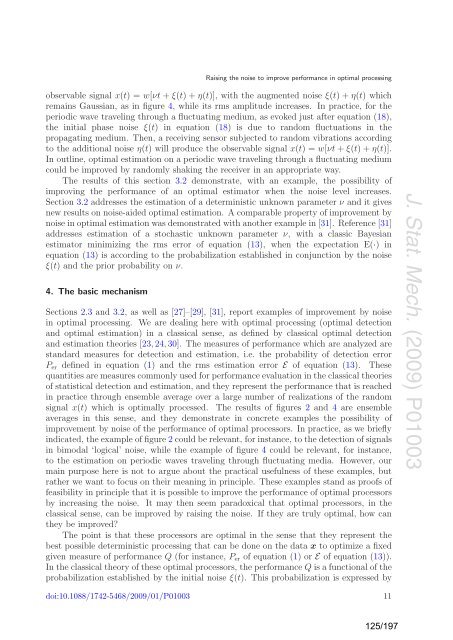a la physique de l'information - Lisa - Université d'Angers
a la physique de l'information - Lisa - Université d'Angers
a la physique de l'information - Lisa - Université d'Angers
Create successful ePaper yourself
Turn your PDF publications into a flip-book with our unique Google optimized e-Paper software.
Raising the noise to improve performance in optimal processing<br />
observable signal x(t) =w[νt + ξ(t)+η(t)], with the augmented noise ξ(t)+η(t) which<br />
remains Gaussian, as in figure 4, while its rms amplitu<strong>de</strong> increases. In practice, for the<br />
periodic wave traveling through a fluctuating medium, as evoked just after equation (18),<br />
the initial phase noise ξ(t) in equation (18) is due to random fluctuations in the<br />
propagating medium. Then, a receiving sensor subjected to random vibrations according<br />
to the additional noise η(t) will produce the observable signal x(t) =w[νt + ξ(t)+η(t)].<br />
In outline, optimal estimation on a periodic wave traveling through a fluctuating medium<br />
could be improved by randomly shaking the receiver in an appropriate way.<br />
The results of this section 3.2 <strong>de</strong>monstrate, with an example, the possibility of<br />
improving the performance of an optimal estimator when the noise level increases.<br />
Section 3.2 addresses the estimation of a <strong>de</strong>terministic unknown parameter ν and it gives<br />
new results on noise-ai<strong>de</strong>d optimal estimation. A comparable property of improvement by<br />
noise in optimal estimation was <strong>de</strong>monstrated with another example in [31]. Reference [31]<br />
addresses estimation of a stochastic unknown parameter ν, with a c<strong>la</strong>ssic Bayesian<br />
estimator minimizing the rms error of equation (13), when the expectation E(·) in<br />
equation (13) is according to the probabilization established in conjunction by the noise<br />
ξ(t) and the prior probability on ν.<br />
4. The basic mechanism<br />
Sections 2.3 and 3.2, aswel<strong>la</strong>s[27]–[29], [31], report examples of improvement by noise<br />
in optimal processing. We are <strong>de</strong>aling here with optimal processing (optimal <strong>de</strong>tection<br />
and optimal estimation) in a c<strong>la</strong>ssical sense, as <strong>de</strong>fined by c<strong>la</strong>ssical optimal <strong>de</strong>tection<br />
and estimation theories [23, 24, 30]. The measures of performance which are analyzed are<br />
standard measures for <strong>de</strong>tection and estimation, i.e. the probability of <strong>de</strong>tection error<br />
Per <strong>de</strong>fined in equation (1) and the rms estimation error E of equation (13). These<br />
quantities are measures commonly used for performance evaluation in the c<strong>la</strong>ssical theories<br />
of statistical <strong>de</strong>tection and estimation, and they represent the performance that is reached<br />
in practice through ensemble average over a <strong>la</strong>rge number of realizations of the random<br />
signal x(t) which is optimally processed. The results of figures 2 and 4 are ensemble<br />
averages in this sense, and they <strong>de</strong>monstrate in concrete examples the possibility of<br />
improvement by noise of the performance of optimal processors. In practice, as we briefly<br />
indicated, the example of figure 2 could be relevant, for instance, to the <strong>de</strong>tection of signals<br />
in bimodal ‘logical’ noise, while the example of figure 4 could be relevant, for instance,<br />
to the estimation on periodic waves traveling through fluctuating media. However, our<br />
main purpose here is not to argue about the practical usefulness of these examples, but<br />
rather we want to focus on their meaning in principle. These examples stand as proofs of<br />
feasibility in principle that it is possible to improve the performance of optimal processors<br />
by increasing the noise. It may then seem paradoxical that optimal processors, in the<br />
c<strong>la</strong>ssical sense, can be improved by raising the noise. If they are truly optimal, how can<br />
they be improved?<br />
The point is that these processors are optimal in the sense that they represent the<br />
best possible <strong>de</strong>terministic processing that can be done on the data x to optimize a fixed<br />
given measure of performance Q (for instance, Per of equation (1) orE of equation (13)).<br />
In the c<strong>la</strong>ssical theory of these optimal processors, the performance Q is a functional of the<br />
probabilization established by the initial noise ξ(t). This probabilization is expressed by<br />
doi:10.1088/1742-5468/2009/01/P01003 11<br />
125/197<br />
J. Stat. Mech. (2009) P01003


